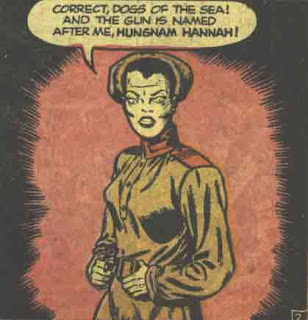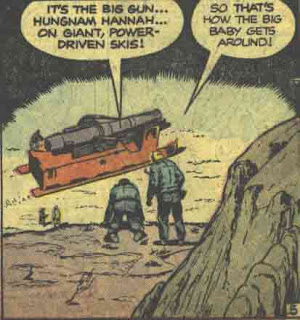
Spider-Girl first penciler was Patrick Olliffe, who drew most of the first 56 issues. Olliffe was already known to Spider-Man fans as the artist of Kurt Busiek's Untold Tales of Spider-Man, which related "unrevealed" stories from the 1960s era of Stan Lee's Spider-Man. Olliffe was therefore perfectly suited for the adventures of Spider-Man's daughter May, whose stories were told in the spirit of Stan Lee.

As well as drawing May's first appearance in What If#105, Ron Frenz has been one of DeFalco's most frequent artistic collaborators, working together on Amazing Spider-Man in the 80s, plus Thor and Thunderstrike. Frenz provided fill-ins for Olliffe during his tenure, then succeeded him as primary artist, seeing the series through all of its incarnations until the very end. Frenz is a skilled imitator of both Jack Kirby and Steve Ditko, even drawing many of his earlier Spider-Man stories in a Ditko-esque fashion; however, for Spider-Girl he used a less traditional style, looser and more energetic.
Both of Spider-Girl's main inkers were legends in their time; Olliffe was usually inked by Al Williamson, one of the all-time greatest inkers in comics, best known for his EC Comics work of the 50s and his intense love for Flash Gordon. Williamson, who passed away earlier this year, lived long enough to see his early work favourably reevaluated; Spider-Girl was something of a finale to his lengthy career. Frenz's inker was primarily Sal Buscema, an able penciler in his own right (just like Williamson) best known for his 1980s Incredible Hulk work; Buscema had also been a frequent Spectacular Spider-Man artist in the 90s. Buscema helped keep a more traditional emphasis to Frenz's lines. Other occasional artists on Spider-Girl included John Livesay, Chris Batista, Casey Jones, Rodney Ramos and Scott Koblish; also worth mentioning is the legendary Bill Sienkiewicz, who inked What If#105.
At the time Spider-Girl launched in 1998, the main line Spider-Man titles were experiencing a rough change in direction. During the 90s, the infamous "Clone Saga" story led to Peter Parker's clone Ben Reilly assuming the Spider-Man identity while Peter retired with his wife Mary Jane, who was pregnant. Only 2 years before Spider-Girl began, Reilly had been suddenly killed off and Peter returned to the costume, while Peter and Mary Jane's baby was lost and presumed dead; there was pressure to kill Mary Jane too in order to restore a single Peter Parker to fandom, but it was felt that this would be going too far.
But in 1998, the relaunched Spider-Man titles began traveling to that very direction. While the main Spider-Man titles were dividing Peter and Mary Jane's relationship and doing their best to pretend the Clone Saga, Ben Reilly and baby May never existed, Spider-Girl reveled in this material.

What If#105 establishes that Peter lost one of his legs in a final battle with the Green Goblin, but discovered baby May was still alive and rescued her. By the time the book opens, "Mayday" is now a teenager while Peter has become a forensic scientist for the police, using his scientific skills to keep fighting crime. May is something of a Peter/Mary Jane gestalt; she's intellectual enough that she consorts with unpopular "nerds" like Courtney Duran and Jimmy Yama, but as a member of the Midtown basketball team she's also accepted by the "jocks," traveling in circles with Moose Mansfield and David Kirby. May also has an immense crush on Brad Miller; like most of her crushes, it's not heading anywhere pretty.

Suddenly, a new Green Goblin appears. This is Normie Osborn, grandson of Norman Osborn (Spider-Man comics of the 90s established Normie as a potential psychopath while he was still a child). In Normie's twisted psyche, his father and grandfather were ruined by Spider-Man so he wants revenge; at the same time Peter tries to decide how to answer Normie's threats, May has begun exhibiting powers exactly like her father's; Mary Jane admits to her that Peter used to be Spider-Man and shows her the costume worn by Ben Reilly; in a nice touch, May refers to him as her "Uncle Ben."

Peter refuses to face Normie as Spider-Man, instead bringing a gun to the fight, hoping to somehow spare his family from the Goblin. However, May arrives dressed in her Uncle Ben's costume; as Spider-Girl she defeats Normie.

Peter can't bear the idea of May becoming a super hero. He has seemingly all of the costumes and web-shooters destroyed, unaware that May hid a pair of web-shooters.

Beginning in Spider-Girl#1, May begins her career as a super hero in earnest, first fighting crime in a lycra bodysuit before sewing a replacement costume. While Peter was motivated to become a hero by personal tragedy - the death of his Uncle Ben - his daughter is seemingly a purer hero, one whose conscience is fully developed and knows she must help others; you could see this as the result of being brought up by Peter and absorbing his values over time. However, Peter becomes increasingly livid at May for continuing to play Spider-Girl against his wishes; he finally decides to "ground" her - taking away her web-shooters to at least make being a hero more difficult.

This is the lead-in to Spider-Girl#17, a pivotal moment in the series. Kaine, a recurring villain from the Clone Saga era, is preparing to assassinate the Kingpin on the day the one-time crime lord is to be brought to court. Realizing that in spite of who he is he can't let the Kingpin die, Peter makes a fateful choice:

However, his artificial leg proves a major hindrance in battle. Ultimately, May arrives and retrieves the web-shooters then completes the mission, defeating Kaine. Seeing May in battle, Peter realizes he was wrong to hold her back.

By the time of this story in the regular Marvel Universe, Mary Jane had been seemingly killed off in order to make Spider-Man single again. This only proved to make fandom spectactularly upset. To the advantage of Spider-Girl, fans began encouraging upset Spider-Man readers to start following her series instead, observing that in at least one title, Peter and Mary Jane were still together. Elements from the Clone Saga were also popular with fans who had been unwilling to dismiss the entire enterprise as a flop. Spill-over from the main Spider-Man titles may not have had a large impact on Spider-Girl's sales, but it brought the book notice at a time when it's future seemed less than certain.
Although Peter's acceptance of May's Spider-Girl career would wax and wane as the series progressed, he and Mary Jane remained supportive of her throughout. In her personal life, May became attracted to Jack Jameson, grandson of the infamous J. Jonah; however, Jack turned out to be a super hero himself, the cocky braggart Buzz; this actually proves to be a turn-off and May breaks up with him without Jack even realizing she was Spider-Girl.

Normie eventually returned and made an attempt on May's life. Unfortunately for May, she had temporarily lost her super powers, placing her entirely at his mercy. To her surprise, Normie, in spite of having her dead to rights and determined to end the Spider/Goblin conflict, refused to kill her. Realizing Normie actually hoped she'd fight back and kill him, she reached out to Normie as a friend and convinced him to make peace with the Parkers, putting an end to the Spider/Goblin conflict.

Normie soon became May's closest ally, supplying her with his weaponry to compensate for her power loss and continuing to donate a secret base and other monetary resources as time went on. May even found herself falling for Normie, but he wound up in a relationship with Raptor, a super villain whom May had helped reform. To her chagrin, Raptor considered May her best friend, making it all but impossible to compete for Normie's affections against her. May finally won her dream date with Brad, but he turned out to be a mutant-hating bigot, quickly killing her interest in him.

In the big issue #50, Peter and Mary Jane gave birth to a son, Ben (or "Benjy"). Immediately following this, issue #51 presented a story written by Sean McKeever...the only issue in the 100 issue run of Spider-Girl not involving Tom DeFalco. At the time, this upset Spider-Girl's fanbase, who considered themselves as much fans of DeFalco as the character. But in the long run, the issue certainly did no harm; Spider-Girl barely appears in #51, which is instead a story about a classmate who has a crush on her writing a letter of confession just before his family leaves town. At the time Sean McKeever was a fresh talent, (barely) known for his independent work the Waiting Place. By breaking in through books like Spider-Girl#51, he was eventually able to make a decent career in comics, including work such as Sentinel, Spider-Man Loves Mary Jane and Teen Titans. McKeever did introduce a daughter of Electro character in issue #51 whom DeFalco would later bring back as Aftershock in #81; more recently, McKeever reintroduced Aftershock as a character in the regular Marvel Universe.

Spider-Girl soldiered on through 100 issues (and an annual), then into the Amazing Spider-Girl run. The series opens with May temporarily retired as a hero, running for student council and dating football star Gene Thompson (son of Flash Thompson), but the call of heroism quickly forces her back into the webs, giving up her personal goals and relationships once more. During this series, a storyline dubbed "Brand New May" (after the main line's "Brand New Day" branding) introduced a clone of May. This clone - usually called April - claimed to be the "real" May in something of a revisit to the original Clone Saga. By the time Amazing Spider-Girl ended with issue #30, May had accepted April into her family.

The saga continued through Amazing Spider-Man Family#1-8, Web of Spider-Man#1-7 and Spectacular Spider-Girl#1-4, finally ending with Spider-Girl: The End#1 (of course). These stories continued May and April's uneasy relationship as May becomes increasingly unhinged and willing to use lethal force, until the two "sisters" are forced to a final confrontation in The End. I won't spoil The End for you, except to say that it's a happy ending.

One of the landmarks Spider-Girl achieved was to become the longest-running super hero series with a female protagonist ever published by Marvel Comics. Spider-Girl made it by running past #61 (previously, She-Hulk was the record holder with 60 issues of Sensational She-Hulk) and with 100 issues total may yet hold that achievement for some time to come.
The landscape of Marvel Comics has changed considerably in the 12 years since Spider-Girl began her adventures. Part of why I've been pleased to see Spider-Girl endure is that in the midst of so many super hero comics where language, violence and sexuality have become explicit, heroes have questionable ethics and art strives for realism rather than imagination, I enjoyed reading one - just one - super hero comic book where the hero endures triumph and tragedy but ultimately beats the odds.
Tomorrow: A closer look at the other MC2 titles.




































